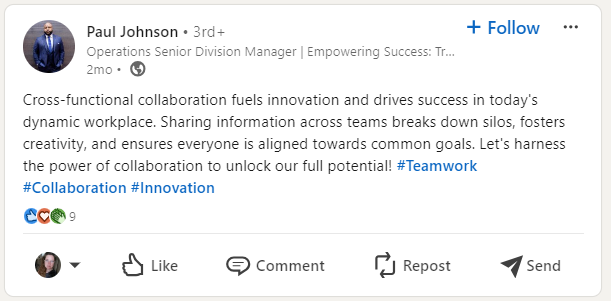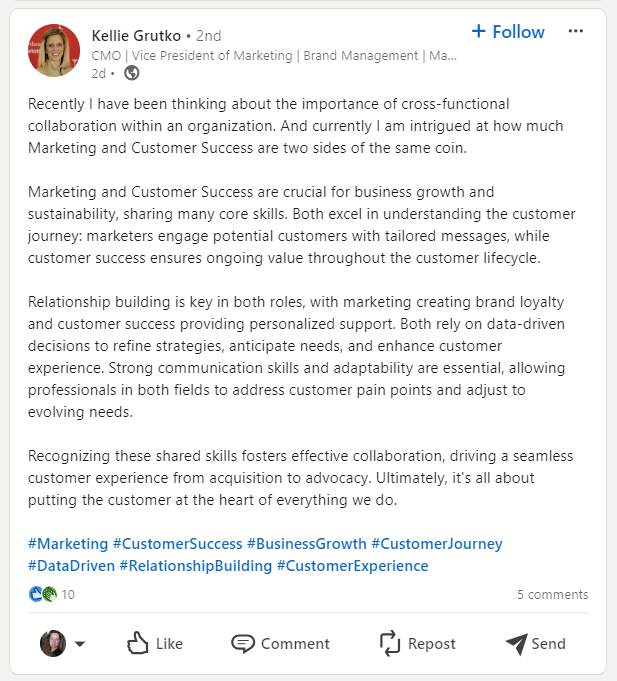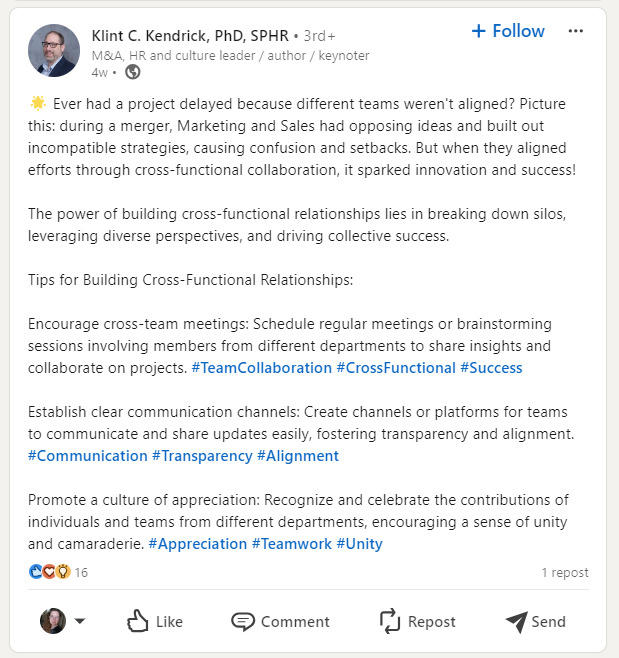Content marketing integration within GTM (Go-to-Market) teams is a must for maximizing the impact of marketing efforts. Effective cross-functional collaboration and strategic alignment across departments can bridge the content gap, ensuring cohesive and comprehensive initiatives that drive business success.
Key Takeaways
- Integrate content marketing across all GTM functions for maximum impact.
- Effective cross-functional communication is crucial for successful content strategies.
- Measuring content’s impact requires both quantitative and qualitative metrics.
- The future of content marketing is promising, with opportunities for innovation and growth.
Unpacking Misconceptions: The True Value of Content Marketing
Content marketing is sometimes misunderstood and undervalued within organizations. This misunderstanding stems from a lack of integration and alignment across GTM teams, leading to fragmented efforts and missed opportunities.
To achieve successful content marketing, close the knowledge gap with a collaborative strategy. This plan should prioritize clear communication and a balance between immediate wins and long-term objectives. By clearing up these misunderstandings, businesses can harness the true power of their content marketing.
Breaking Down Silos: The Importance of Integrated Content Strategies
Content marketing often exists in silos within GTM teams, leading to fragmented efforts and missed opportunities. Without integration across departments, content initiatives can fail to deliver comprehensive benefits to the business.
Obaid Durrani, in a recent report published by Beam Content, highlights the importance of a cohesive strategy. He says, “Without a unified strategic purpose, success in one channel doesn’t necessarily translate to leads and revenue for the company as a whole.”
Content Marketing Institute reports that while 72% of B2B marketers use generative AI tools, only 31% have guidelines for their use. This statistic underscores the need for structured and cohesive content strategies to maximize effectiveness and alignment with business goals.
💡 Action Items:
- Conduct a content audit to identify silos: Assess current content efforts to spot areas of isolation and overlap.
- Develop a unified content strategy: Align content creation and distribution with overall business objectives to ensure all efforts contribute to shared goals.
Beyond a ‘Nice to Have’: Recognizing the Strategic Value of Content
Despite its potential, some organizations undervalue content. Tara Pawlak addresses this issue in Beam’s report, “I think it’s a historical problem, a very common perspective, to look at content marketing as a ‘nice to have.’” This viewpoint can lead to underinvestment in content initiatives and a lack of recognition for their strategic importance.
Common misconceptions about content marketing include beliefs that it is only supplementary or that its impact is difficult to measure. However, evidence shows otherwise. Nearly 30% of B2B marketers cite the creation of the right content for the audience as their biggest challenge. This data highlights the necessity for precise and targeted content strategies.
💡 Action Items:
- Educate stakeholders on the strategic value of content marketing: Use presentations and discussions to highlight how content supports business goals.
- Use case studies and data to demonstrate content marketing’s impact: Provide concrete examples and statistics that link content efforts to revenue and lead generation, making the value clear and undeniable.
The Value of Cross-Functional Collaboration
Cross-functional collaboration is vital for aligning content marketing efforts with broader business goals. By breaking down silos and fostering cooperation across departments, companies can ensure that their content strategy supports and enhances overall objectives. Effective collaboration enables the sharing of insights, resources, and expertise, leading to more cohesive and impactful marketing initiatives.

Current State of Collaboration
Effective collaboration between content marketers and other departments is crucial for a cohesive and successful GTM strategy. However, statistics reveal that only 57% of non-content marketers said they collaborate frequently with content marketing on initiatives.
Content marketers often face challenges in communication with other departments. As noted in Beam’s report, “Content marketers and others in the GTM org agree: cross-functional communication is moderately effective, but could definitely use some work.”
💡 Action Items:
- Schedule regular cross-departmental meetings: Facilitate discussions on content strategy and departmental needs to ensure everyone is on the same page.
- Create shared project management documents: Increase transparency and collaboration by maintaining accessible and updated project management tools.
Improving Cross-Functional Communication
Understanding roles and responsibilities is fundamental to improving communication and collaboration. Gail Marie shares in Beam’s report, “First, figure out who’s responsible for what and how roles intersect. Using a RACI matrix as a visual helps to see who is responsible, accountable, consulted, and informed for GTM tasks.”
Implementing a RACI matrix can provide clarity and streamline responsibilities, ensuring everyone knows their roles and how they contribute to the overall strategy.
Building routine and regular communication channels is another critical step. James Carbary, Founder of Sweet Fish Media, also commented on Beam’s report. He suggests, “Finding a few GTM folks who have the insights your content needs and sending them recurring calendar invites for a quick recorded session” can significantly enhance the flow of information and collaboration.

Data shows that 65% of B2C marketers prioritize the audience’s informational needs over sales/promotional messages (Ahrefs), highlighting the importance of aligning content with what truly matters to the audience.
💡 Action Items:
- Implement a RACI matrix: Clearly define roles and responsibilities to avoid confusion and overlap.
- Develop communication protocols: Ensure all departments are informed and aligned by establishing regular and structured communication practices.
Detailed Strategies and Tactics
Effectively unifying content marketing efforts across GTM teams involves employing a set of strategic measures that facilitate integration and cooperation. By implementing detailed strategies and tactical approaches, organizations can ensure a smooth workflow and alignment between various departments, ultimately driving greater efficiency and effectiveness in their marketing endeavors.
Integration Tactics
A unified content marketing approach across GTM teams is the cornerstone of a powerful marketing strategy. Here are specific tactics to achieve this:
- Joint planning sessions: Schedule regular meetings where representatives from content marketing, sales, product, and other GTM functions can collaborate on planning and strategy. Doing so ensures everyone is aligned and working towards common goals.
- Collaborative content calendars: Develop a shared content calendar that includes input from all relevant departments. This resource helps coordinate content production and distribution, ensuring that all teams are aware of upcoming content and can contribute to its success.
- Shared KPIs: Establish key performance indicators (KPIs) that are relevant to all GTM teams. This strategy creates a unified framework for measuring success and ensures that all departments are working towards the same objectives.
Enhancing Communication: Tools and Tactics for GTM Teams
Effective communication is crucial for successful collaboration. Here are some recommended tools and platforms to facilitate cross-functional communication:
- Project management software: Tools like Asana, Trello, and Monday.com can help manage projects, assign tasks, and track progress across teams.
- Communication Apps: Platforms such as Slack, Microsoft Teams, and Zoom enable real-time communication and collaboration.
- Content Management Systems (CMS): A robust CMS like WordPress, HubSpot, or nDash can streamline content creation, management, and distribution, ensuring that all teams have access to the latest content and resources.
From Metrics to Impact: Mastering Content Performance Evaluation
Understanding the true impact of content marketing is crucial for optimizing strategies and demonstrating value to stakeholders. By accurately measuring both immediate and long-term outcomes, content marketers can refine their approaches and better align with business goals.
Diving Into Content Marketing Metrics
Content marketers often face challenges with misunderstood metrics, as there is a persistent gap between short-term results and long-term brand-building efforts. While short-term metrics are crucial for immediate performance evaluation, they do not always reflect the broader, long-term value that content brings to brand development.
The study we mentioned earlier by the Content Marketing Institute highlights the most common metrics used to assess content performance:
- Conversions (73%)
- Email engagement (71%)
- Website traffic (71%)
- Website engagement (69%)
- Social media analytics (65%)
These metrics, while valuable, must be balanced with a view towards long-term growth.
💡 Action Items:
- Identify and track both short-term and long-term metrics: Ensure a holistic approach to measuring content effectiveness.
- Use dashboards to review and report on content performance regularly: Maintain a comprehensive view of metrics to guide strategic decisions.
Quantifying Success: The Essential Metrics for Content Marketing
Evaluating content success requires a blend of key metrics and a consideration of both qualitative and quantitative success indicators. It’s essential to recognize that numbers alone do not tell the full story; feedback from customers and stakeholders provides critical context.
Effective content distribution strategies also play a significant role in content success. According to Semrush, 94% of B2B marketers create short articles or posts, and 84% use videos. These formats are popular and can be highly effective when distributed strategically.
💡 Action Items:
- Incorporate qualitative feedback from customers and stakeholders into performance reviews: Use insights to enhance and refine content strategies.
- Regularly update and refine content based on performance data: Stay agile and responsive to ensure content remains relevant and impactful.
Metrics and Measurement Techniques
To examine the effectiveness of your content marketing in depth, you need strong metrics and measurement tools. This strategy involves tracking traditional performance indicators and embracing a comprehensive approach that considers both quantitative and qualitative data.
By doing so, content marketing managers can gain deeper insights into the effectiveness of their strategies. They can then make more informed decisions to drive continuous improvement.
“With strong cross-functional collaboration, you get customer-informed innovation and pre-validated demand without fracturing your focus on strategic initiatives. The key is that everyone focuses on winning the target market with a product that doesn’t require one-off customizations—everyone is focused on innovation that scales.”
Comprehensive Metrics
Gauging the true impact of content marketing involves using a combination of hard data and insightful qualitative metrics. Here are some key metrics to consider:
- Engagement rates: Monitor key metrics like dwell time, bounce rate, and social media buzz to understand how well your content engages with your audience.
- Lead generation: Quantify lead generation through content by tracking form submissions, downloads, and event sign-ups.
- Conversion rates: Track conversion rates of leads nurtured by your content marketing to measure its impact on customer acquisition.
- Customer feedback: Collect qualitative feedback from customers through surveys, comments, and direct interactions to understand their perceptions of your content.
ROI Calculation
Measuring content marketing ROI goes beyond just the bottom line. Consider both the immediate gains and the long-term value it brings. Here’s a guideline to help you calculate ROI:
- Identify costs: Include all costs associated with content creation, distribution, and promotion.
- Measure direct revenue: Track revenue generated directly from content marketing efforts, such as sales attributed to content-driven leads.
- Consider indirect benefits: Account for indirect benefits such as increased brand awareness, improved customer loyalty, and enhanced SEO performance.
- Calculate ROI: Use the formula ROI = (Revenue – Costs) / Costs to determine the overall return on your content marketing investment.
Best Practices and Lessons Learned
Integrating content marketing within GTM teams requires a thoughtful approach that incorporates proven strategies and learns from past experiences. Understanding and applying best practices allows content marketing managers to navigate common challenges and optimize their efforts for better alignment and results.

Here are some best practices for integrating content marketing within GTM teams:
- Align content with business goals: Ensure that all content initiatives support the overall business objectives and contribute to achieving key goals.
- Foster collaboration: Encourage regular communication and collaboration between content marketing and other departments to create a unified approach.
- Use data: Leverage data and analytics to inform content strategies, track performance, and make data-driven decisions.
Learning from past experiences can help avoid common pitfalls. Here are some lessons learned from companies that have succeeded and struggled with content marketing integration:
- Avoid siloed efforts: Silos can lead to disjointed and ineffective content strategies. Promote cross-departmental collaboration to avoid this issue.
- Prioritize quality over quantity: Producing a large volume of content without focusing on quality can dilute your brand’s message. Focus on creating valuable, high-quality content.
- Stay agile: Embrace an agile content marketing approach and be ready to pivot strategies based on data insights and evolving market trends.
Unifying GTM Efforts for Effective Content Marketing
Bridging the content gap through collaboration, strategic alignment, and continuous improvement is essential for effective content marketing. By integrating content marketing across all GTM functions, organizations can ensure that their efforts are cohesive and impactful. Strategic alignment allows content to support overall business goals, while continuous improvement in content quality and measurement ensures that strategies remain effective and relevant.
Translating insights and strategies into practical actions is essential to ensuring the successful integration of content marketing within GTM teams. By focusing on specific, achievable steps, content marketing managers can drive continuous improvement and tangible results.
Actionable Steps
To improve your content marketing strategies and integration efforts, here are some clear, actionable steps:
- Conduct a content audit: Regularly review and assess your content to identify gaps, overlaps, and opportunities for improvement.
- Develop a unified strategy: Create a comprehensive content strategy that involves input from all relevant departments and aligns with overall business goals.
- Implement communication protocols: Establish regular meetings, shared tools, and clear communication channels to facilitate collaboration.
Checklist
Use this checklist to assess and enhance your current content marketing practices:
- Conduct regular content audits.
- Schedule joint planning sessions with GTM teams.
- Develop and maintain a shared content calendar.
- Establish shared KPIs for content marketing initiatives.
- Utilize project management and communication tools.
- Track and analyze comprehensive metrics.
- Calculate ROI for content marketing efforts.
- Foster a company culture of continuous learning and improvement.
Implement these recommendations to build a stronger content strategy. An integrated, data-driven approach will lead to greater success and alignment with your business goals.
